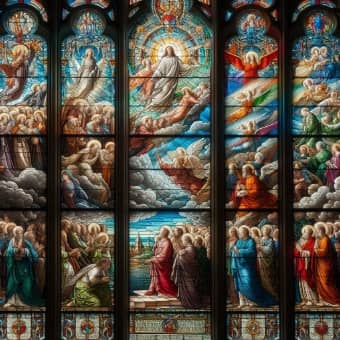The Art Of Iconography In The Catholic Church
Iconography, the art of creating and using religious images, has a deep and rich history within the Catholic Church. These sacred images serve as visual theology, tools for teaching the faith, and aids for devotion. To appreciate the full impact of iconography, it is crucial to understand its origins, development, and significance within the Church.
This blog post contains affiliate links. When you click on a link on this page and make a purchase I may earn a small commission, at no additional cost to you. Thank you for your support.
Historical Origins
Iconography has its roots in early Christianity, where icons were primarily used in the catacombs and homes of the faithful. By the 4th century, the practice became more widespread as Christianity gained legal status in the Roman Empire. The establishment of churches provided larger spaces for the display of religious art.
The early Christians adapted iconographic styles from Roman and Byzantine art, incorporating symbols and scenes from scripture to communicate theological concepts. This period set the foundation for the development of a unique Christian iconographic tradition.

Development Through The Ages
Byzantine Influence
Byzantine art profoundly influenced early and medieval Christian iconography. Characterized by its use of gold backgrounds, elongated figures, and hierarchical compositions, Byzantine icons aimed to convey a sense of the divine and the eternal.
These images were not mere decorations but theological statements encapsulating the essence of heavenly realities.
Western Medieval Art
In the West, iconography evolved differently. Gothic art introduced more naturalism and emotional expression into religious images. Figures became more humanized, reflecting a growing emphasis on Christ’s humanity and the lives of the saints.
The stained-glass windows of Gothic cathedrals served as instructional tools, depicting biblical narratives and saintly lives for an illiterate populace.
Renaissance Transformation
The Renaissance period marked a significant transformation in iconography. Artists like Michelangelo, Raphael, and Leonardo da Vinci brought a renewed interest in classical antiquity, human anatomy, and perspective. While the humanization of religious figures continued, the spiritual essence remained intact, aiming to lift viewers’ minds to divine truths.
Symbolism In Iconography
Catholic icons are rich with symbolism designed to convey deeper meanings:
Halos: Symbolize holiness and the presence of divine light.
Colors: Different colors carry specific meanings; blue often represents heaven, red symbolizes martyrdom, and green denotes life and rebirth.
Gestures: Hand positions and gestures often convey blessings, teachings, or intercessions.
Attributes: Saints are frequently depicted with their unique attributes, like St. Peter with keys or St. Lawrence with a gridiron, making them easily identifiable.
Theological Significance
Iconography serves several crucial functions within the Catholic Church:
Catechesis: Icons are teaching tools, visually presenting the stories and doctrines of the faith.
Devotion: They aid personal and communal devotion, serving as focal points for prayer and meditation.
Liturgical Use: Icons play an integral role in the liturgy, especially in the Eastern Catholic rites where icons are venerated and used in processions.
Modern Perspectives
Today, iconography continues to be a vibrant and evolving tradition. Contemporary artists strive to balance maintaining traditional techniques and symbolism with addressing modern sensibilities and themes. Workshops and courses on iconography are increasingly popular, ensuring the transmission of skills and knowledge to future generations.
Dive Deeper into Catholic Art with This Stunning Book
Unveil the captivating world of Catholic iconography with Catholica: The Visual Culture of Catholicism. This beautifully illustrated book offers a comprehensive exploration of the symbols, stories, and spiritual depth embedded in Catholic art. From the holy family to sacred spaces, discover the rich tapestry of meaning that adorns our churches, homes, and hearts.
Ignite your faith and artistic appreciation with Catholica. Order your copy today and embark on a transformative journey through the visual language of Catholicism.
Conclusion
The art of iconography in the Catholic Church is a testament to the enduring power of visual images to communicate faith, inspire devotion, and transmit theological truths. As both historical treasures and living traditions, icons invite the faithful to contemplate the mysteries of the divine through the lens of beauty and artistry.
Looking for unique Catholic gifts? Check out our gift guide!
